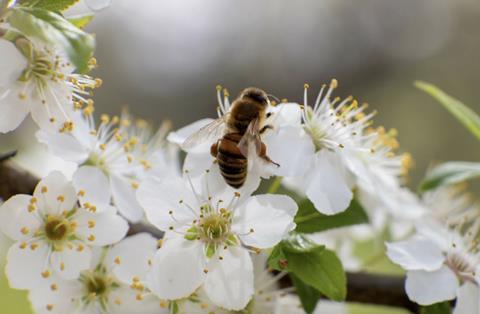Honeybees and pollination are highlighted as crucial sustainability practices in new Hortgro report
Around the world, deciduous fruit growers are increasingly using netting to advance their production practices with the view of increasing yields and farm income.

This is where growers must use innovative ideas so as to not disrupt the natural process of pollination that will ultimately ensure their fruit set and profitability.
The erection of nets to improve tree growth and development in early years brings orchards into production much earlier and cuts costs, as well as avoiding wind and other damage when the fruit is ripening on the trees.
In this scenario pollination at the optimum time is extremely important. This is where the humble bee normally works its magic – with nets and bees having to come together in the same environment.
This is according to a new report for fruit growers highlighting the conflict between netting and honeybees, produced by Anna Mouton of Hortgro.
“The pollination of plums is super-important,” says stonefruit grower and technical adviser Petru du Plessis. “If you have correct pollination in September, you can look forward to a fantastic and profitable harvest. But if your pollination failed, you have the terrible prospect of staring at an unprofitable orchard for the rest of the season.”
Du Plessis champions the erection of nets to improve plum yields and pack-outs. He began netting his orchards at Bon Esperance in Stellenbosch six years ago with a fixed structure.
“Unfortunately, I soon sacrificed about 15 tonnes per hectare of his yield during the first two years,” he says, “because the nets limit the bees and slow down pollination.”
It appears that the nets baffle the bees and they lose their way when they want to return to their hives. Baffled bees are not what you need during peak pollination periods, when things get quite busy in the orchards, whether it is stone fruit or apple and pear orchards.
“Generally, when bees want to return to their hives, they fly up and out of the orchard,” says pomefruit grower Mike Leslie, who farms at Clan Leslie in the Free State. “But under nets, they bump against the top and get stuck as they try to get out. So you lose some bees like that as well.”
In Leslie’s case nets mainly serve as hail protection and are open at the sides. He notes that bees also get stuck when they fly out of the nets and try to return to hives inside the nets.
“If bees are inside the net, they can see gaps to get out because the sun shines from above,” says third-generation beekeeper Trevor Pye. “Once they fly out and go up, they can’t see the box below, and they can’t find the gaps to get back inside the net again, so they die on the outside of the net.”
This is not something that fruit growers can tolerate, especially with the increasing focus on natural processes so high on the agenda. “I feel that you need more hives and a longer pollination period to get the same fruit set under fixed nets.”
“But growers don’t necessarily have the luxury of time when it comes to pollination,” says Mouton. ”Already brief, effective pollination periods in many cultivars can be further condensed by unfavourable weather. Weather also influences pollinator activity — honeybees down tools when it’s too hot, cold, wet, or windy,”
Furthermore, in many fruit types, the first flowers to open often develop into the largest fruit due to superior flower-bud quality and a longer fruit growth period. Growers don’t want to waste these flowers due to floundering bees.
Du Plessis has solved his pollination woes by switching from fixed to retractable nets. “As soon as we finish picking the fruit, we roll the nets up, and we roll them open in spring as soon as the bee hives have been removed.”
Leslie has adopted a similar strategy for his apples. “We used to cover the trees as they started to flower because the nets kept the orchards slightly warm. But in the last couple of years, we have held back until the bees have finished pollinating, and we think we’re getting better pollination and fruit set.”
Du Plessis’s nets are primarily used to prevent wind damage. He explains that plum fruitlets become vulnerable to wind about three weeks after set. Since not all plum cultivars flower simultaneously and his teams can close more than a hectare of nets in a day, there is plenty of time to cover the trees after pollination.
Other growers will no doubt find other ways to solve the quandary the bees find themselves in.
So, living with the needs of bees has always been and will always be a priority for fruit growers. “Bees are like people,” remarks Du Plessis. “They need food and water. And if you don’t give them water, they can’t function.”
Similarly, if they cannot get to their nets, they are lost.
Leslie thinks wildflowers such as dandelions help draw bees into his orchards at the end of winter when the surrounding countryside has nothing to offer. He is considering planting cover crops or other flowers to further capitalise on this effect.
This is where older fruit growing methods team up with modern production to achieve optimum, sustainable fruit growing in South Africa’s orchards.



